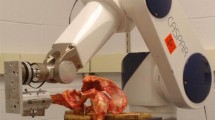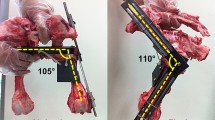Abstract
Purpose
The function of the hip labrum during hip motion remains poorly known. Our hypothesis was that acetabular labrum will deform and change its shape during adduction to abduction movement consecutively to variation of strains passing from the acetabulum to the femoral head. An ex vivo anatomical study was conducted to analyse the morphological parameters variation of the mid-portion of the labrum (length, thickness, shape, deformation) as well as femoro-labral strains during hip adduction to abduction movement.
Methods
Ten fresh-frozen, unpaired human cadaver hemi-pelvises were obtained. To best approximate the clinical reality, fresh-frozen cadaver tissues were utilized. The hemi-pelvises were split sagittally in two equal parts through a plane crossing the femoral neck and femoral head centres. The hemi-pelvises were rigidly mounted on a test platform using a custom-made fixture, and a seven hundred Newton load was applied through the iliac wing, with a unidirectional movement (adduction/abduction) of the acetabulum above the fixed femur. Variations of strain passing from the labrum to the femoral head or neck were analysed using captors fixed on the acetabular edge.
Results
From 20° to 40° of abduction labral length decreased from a median of 5.8 (5.5–6.4 mm) to 4.6 (4–5.4 mm), labral edge angle increased from a median of 33.1 (31.1°–40°) to 52.3 (41.4°–58.8°), labral sectional area decreased from a median of 22.1 (17–27.1 mm2) to 14.2 (12–16.8 mm2) all p = 0.001. Femoro-labral strains were maximal at 40° of abduction [median 0.1 N mm−2 (0.1–3.1 N mm−2)] and minimal at 30° adduction (median 0 N mm−2 (0–0.1 N mm−2) and p = 0.001).
Conclusion
The morphological variations of the mid-portion of the labrum during hip motion reflect strains passing from the labrum to the femoral head. Those elements may provide clues to understand the mechanical role of the labrum during abduction. The acetabular labrum bears a direct mechanical role during hip motion, thus resecting the hip’s labrum during surgery might be detrimental for hip joint’s biomechanics as it might modify strains distribution between the acetabulum and femur.






Similar content being viewed by others
References
Crawford MJ, Dy CJ, Alexander JW, Thompson M, Schroder SJ, Vega CE, Patel RV, Miller AR, McCarthy JC, Lowe WR, Noble PC (2007) The 2007 Frank Stinchfield Award: the biomechanics of the hip labrum and the stability of the hip. Clin Orthop Relat Res 465:16–22
Dy CJ, Thompson MT, Crawford MJ, Alexander JW, McCarthy JC, Noble PC (2008) Tensile strain in the anterior part of the acetabular labrum during provocative maneuvering of the normal hip. J Bone Joint Surg Am 90:1464–1472
Ferguson SJ, Bryant JT, Ganz R, Ito K (2000) The influence of the acetabular labrum on hip joint cartilage consolidation: a poroelastic finite element model. J Biomech 33:953–960
Ferguson SJ, Bryant JT, Ganz R, Ito K (2000) The acetabular labrum seal: a poroelastic finite element model. Clin Biomech (Bristol, Avon) 15:463–468
Ishiko T, Naito M, Moriyama S (2005) Tensile properties of the human acetabular labrum-the first report. J Orthop Res 23:1448–1453
Kelly BT, Shapiro GS, Digiovanni CW, Buly RL, Potter HG, Hannafin JA (2005) Vascularity of the hip labrum: a cadaveric investigation. Arthroscopy 21:3–11
Kim YT, Azuma H (1995) The nerve endings of the acetabular labrum. Clin Orthop Relat Res 320:176–181
Konrath GA, Hamel AJ, Olson SA, Bay B, Sharkey NA (1998) The role of the acetabular labrum and the transverse acetabular ligament in load transmission in the hip. J Bone Joint Surg Am 80:1781–1788
Lee S, Wuerz TH, Shewman E, McCormick FM, Salata MJ, Philippon MJ, Nho SJ (2015) Labral reconstruction with iliotibial band autografts and semitendinosus allografts improves hip joint contact area and contact pressure: an in vitro analysis. AJSM 43:98–104
McCarthy J, Barsoum W, Puri L, Lee J, Murphy S, Cooke P (2003) The role of hip arthroscopy in the elite athlete. Clin Orthop Relat Res 406:71–74
Nepple JJ, Philippon MJ, Campbell KJ, Dornan GJ, Jansson KS, LaPrade RF, Wijdicks CA (2014) The hip fluid seal–Part II: the effect of an acetabular labral tear, repair, resection, and reconstruction on hip stability to distraction. Knee Surg Sports Traumatol Arthrosc 22:730–736
Petersen W, Petersen F, Tillmann B (2003) Structure and vascularization of the acetabular labrum with regard to the pathogenesis and healing of labral lesions. Arch Orthop Trauma Surg 123:283–288
Philippon MJ, Nepple JJ, Campbell KJ, Dornan GJ, Jansson KS, LaPrade RF, Wijdicks CA (2014) The hip fluid seal–part I: the effect of an acetabular labral tear, repair, resection, and reconstruction on hip fluid pressurization. Knee Surg Sports Traumatol Arthrosc 22:722–729
Roylance D (1995) Mechanics of materials. Wiley, New York, p 336
Safran MR (2010) The acetabular labrum: anatomic and functional characteristics and rationale for surgical intervention. J Am Acad Orthop Surg 18:338–345
Safran MR, Giordano G, Lindsey DP, Gold GE, Rosenberg J, Zaffagnini S, Giori NJ (2011) Strains across the acetabular labrum during hip motion: a cadaveric model. Am J Sports Med 39(Suppl):92S–102S
Seldes RM, Tan V, Hunt J, Katz M, Winiarsky R, Fitzgerald RH (2001) Anatomy, histologic features, and vascularity of the adult acetabular labrum. Clin Orthop Relat Res 382:232–240
Wenger DE, Kendell KR, Miner MR, Trousdale RT (2004) Acetabular labral tears rarely occur in the absence of bony abnormalities. Clin Orthop Relat Res 426:145–150
Acknowledgements
Funding was provided by Sofcot.
Author information
Authors and Affiliations
Corresponding author
Ethics declarations
Conflict of interest
Matthieu Ollivier received a “SOFCOT” Grant to perform a one-year fellowship. All of the other authors have nothing to disclose regarding this research protocol.
Funding
The study was funded by faculté de medecine Paris Descartes.
Ethical approval
Institutional review board approval was not required because of the use of de-identified cadaveric specimens. The Université Paris Descartes Scientific Review board approved the content of the study and provided funding for the research protocol.
Informed consent
None.
Rights and permissions
About this article
Cite this article
Ollivier, M., Le Corroller, T., Parratte, S. et al. Mechanical strains passing through the acetabular labrum modify its shape during hip motion: an anatomical study. Knee Surg Sports Traumatol Arthrosc 25, 1967–1974 (2017). https://doi.org/10.1007/s00167-017-4524-8
Received:
Accepted:
Published:
Issue Date:
DOI: https://doi.org/10.1007/s00167-017-4524-8




